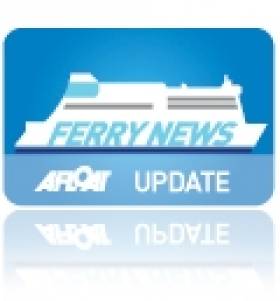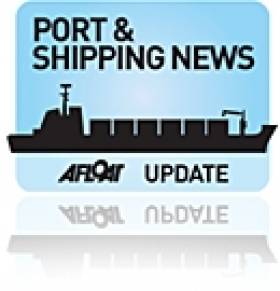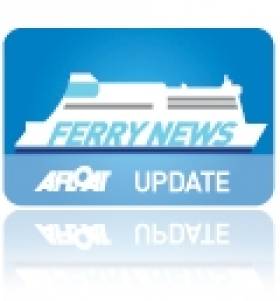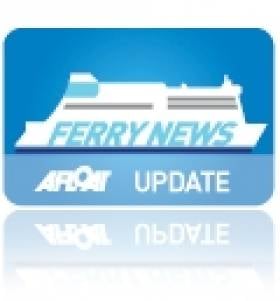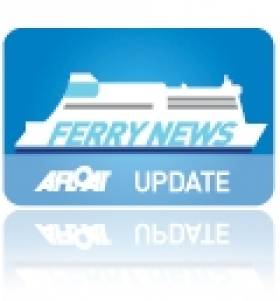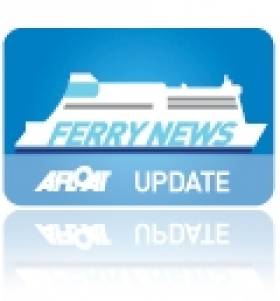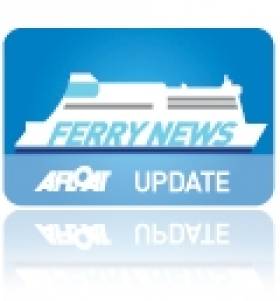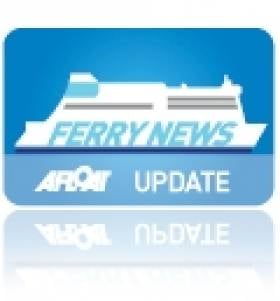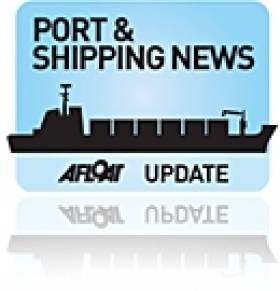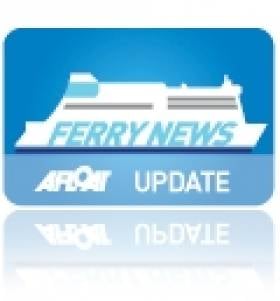Displaying items by tag: Irish Ferries
Ferry to France Forced to Abandon Approach to Port
#Ferry News – Due to heavy seas, Irish Ferries French route vessel, Oscar Wilde had to abandon its approach to Cherbourg last night.
The cruiseferry with more than 500 passengers had departed Rosslare and made several attempts to dock at the French port with the assistance of tugs in winds of up to 100km an hour.
One crew member suffered a broken leg during one of the failed attempts after a line snapped. He is still on board but a spokesperson for Irish Ferries says he is being well catered for on board. For more the Irish Examiner reports.
According to the Irish Ferries website, the vessel is currently offshore of Cherbourg and is awaiting an improvement in weather conditions before a further attempt to berth will be made at 13.00 hours local time today.
Irish Continental Group Statement of Results for 2012
#Shipping – The Irish Continental Group (ICG) parent company of Irish Ferries, have released a statement of results for the year ended 2012.
Commenting on the results Chairman John B McGuckian said,''These are resilient results in the face of a challenging economic background. There is now some emerging evidence of an improvement in the Irish economic environment, but we remain cautious, particularly in relation to freight capacity.''
ICG produced another resilient performance in the face of continued economic weakness, which affects both consumer travel and import / export trade flows, the two areas of economic interest for the Group.
During the year the group announced, and completed, the sale of its subsidiary Feederlink. Consequently the results for the group's continuing operations (i.e. excluding Feederlink for both 2012 and 2011) are set out below.
Revenue for the year from continuing operations was up 1.7% at €256.1 million while continuing EBITDA1 was down 3.2%, to €45.8 million, due mainly to lower freight volumes in both Ro-Ro and Lo-Lo and higher fuel costs (up €6.3 million to €53.2 million) largely offset by higher yields in the passenger business.
The net interest charge was €1.8 million (2011: €1.0 million) before a net interest expense from defined benefit pension schemes of €1.6 million (2011: credit of €0.3 million). The taxation charge was €0.5 million compared with €0.8 million in 2011.
The profit on sale of Feederlink was €21.0 million. Basic EPS including the profit on sale of Feederlink was 183.2 cent while adjusted EPS from continuing operations was 104.6 cent, up 3.1%.
For further information of the statement of results, click HERE for PDF download.
Oscar Reopens French Route Season
#FrenchRoute-Irish Ferries set sail for France today on board cruiseferry Oscar Wilde, which launches the 2013 season with a night-time departure on the Rosslare-Cherbourg route.
Irish Ferries are currently offering a fare from €99 car & driver & reserved seat. The price includes all taxes if booked at least 10 days in advance of travel date.
Oscar Wilde made her debut on the continental service in 2007, she has extensive passenger facilities and a wide choice of cabin accommodation, having served in Scandinavian waters with Color Line.
She recently returned to Rosslare, fresh from annual maintenance carried out at the Cammell Laird dry-dock facility in Birkenhead. In May the Rosslare-Roscoff route resumes a peak-season operated service.
The 162,000 kms ‘Swifty’ Returns to Service
#DublinSwift- Jonathan Swift, Irish Ferries fastferry returned fresh to the Dublin-Holyhead service this week, following annual drydocking maintenance in Birkenhead, writes Jehan Ashmore.
- The central corridor route, which is a distance of 60 nautical miles (111 Kms) takes Jonathan Swift only 1 hour 49 minutes while running at up to 40 knots (80kph). So with each crossing, the Dublin Swift, (her marketing name), consumes 15 tonnes of marine diesel oil and in every year she clocks up an impressive total of 162,000 kms.
As previously reported, the Irish Ferrries fleet took in turn annual dry-docking at Cammel Laird, Birkenhead, where the Austal Auto-Express 86m built catamaran craft completed in Fremantle, western Australia, became the last vessel to receive work out of the company's other Irish Sea vessels, flagship Ulysses and cruiseferry Isle of Inishmore.
Now that Isle of Inishmore is back running Rosslare-Pembroke Dock sailings, previously covered by French routes cruiseferry, Oscar Wilde, which is currently undergoing overhaul in Birkenhead.
Oscar Wilde, a former Scandinavian overnight ferry, is scheduled to launch 2013 sailings, firstly Rosslare-Cherbourg on 27 February followed by the peak-season Rosslare-Roscoff route on 10 May.
Sail to the Six Nations Rugby in Dublin
#RUGBYFerry – Following the Irish rugby victory against the Welsh, Irish Ferries has space for fans wanting to watch the next RBS Six Nations match, when England encounter the team in green back on home ground in Dublin on 10 February.
The Holyhead-Dublin cruiseferry Ulysses, recently returned fresh from refit, will have plenty of space, with a capacity to handle more than 1,800 passengers and up to 1,300 cars alone. Fares on the route for a car and four people are available at around £108 per person return.
"We have four sailings a day into Dublin," says head of passenger sales Dermot Merrigan, "and we're always busy on match weekends. But with flight prices soaring around Six Nations dates, not to mention the baggage issues, a trip by car is a much more cost-effective and stress-free option."
SailRail tickets for foot passengers are also available, with combined ship and rail tickets from British mainline stations to Dublin from £76 per person return.
For further details contact: 08717 300 400 www.irishferries.com and for SailRail click HERE.
Not a 'Fast-Ferry' to Be Seen on the Irish Sea
#DublinSwift – The are currently no fast-ferries operating at all on the Irish Sea, not due to bad weather, but for the annual refit of Jonathan Swift, the only such craft running throughout the year, on Irish Ferries Dublin-Holyhead route, writes Jehan Ashmore.
Irish Ferries which markets the fast-craft as the Dublin 'Swift' is currently undergoing maintenance at the Cammell Laird dry-dock facility, Birkenhead. Her brief absence from the route started during the week, however she to resume service on Tuesday 5 February with the 08:45 sailing from Dublin Port.
Also berthed in Birkenhead, is Irish Ferries cruiseferry Isle of Inishmore, which too is undergoing annual refit. As previously reported on Afloat.ie, the flagship Ulysses, the largest ferry on the Irish Sea, was also refitted at the same facility recently, as she returned earlier this week to the Dublin-Holyhead service.
So where are the rest of the fast-ferries?...well, there's three to be found in 'hibernation' mode. Firstly, facing opposite Birkenhead, the Isle of Man Steam Packet Company's fast-ferry Manannan is laying over for the winter in Liverpool docks, until required to operate routes to Douglas in the Spring.
Stena Line's HSS Stena Explorer is in lay-up at her berth in the inner harbour in Holyhead, where she is to remain until resuming her seasonal-only service starting on 22 March and running through the peak-season until September.
Finally the third fast-ferry, P&O's Express is berthed alongside Donegall Quay, Belfast, though this is not where she operates from, but on the seasonal Larne-Troon service.
Also to be found in Belfast is the laid-up HSS Stena Voyager, one of a trio of HSS 1500 series built in Finland. She became redundant more than a year ago following change of Scottish ferryport from Stranraer to Cairnryan, from where a pair of 'Superfast' ferries operate the North Channel route to Belfast.
Ferry Operator Rolls Out Green Carpet to ‘Gathering’ Tourists
#FERRY & COACH – In support of the Government's 'The Gathering' initiatives, Irish Ferries is rolling out its own 'green carpet' in pledges worth up to EUR60,000, so to attract overseas visitors from Britain to Ireland this year.
Commenting on the pledges, Irish Ferries Head of Passenger Sales, Dermot Merrigan said "As Ireland's national sea carrier, we plan to play our part in attracting groups from our biggest overseas tourism market – Britain – and ensure that tourism providers around the country benefit to the greatest extent possible from the Government's plan".
First of the support packages, are 100 free return coach spaces that have been set aside on its Holyhead-Dublin and Pembroke Dock-Rosslare routes this year, to support groups wishing to attend the year-long Gathering of events.
Valued at up to GB£50,000 and available to eligible groups participating in officially registered events, this offer is billed as just one of a selection of 'green carpet' offers which the company plans to make available as part of a programme of support for this initiative.
The offer is for a free return carriage to Ireland for groups travelling with coaches, which includes -small mini buses to vehicles with seating for up to 30 passengers. With free coach spaces on offer for travel every week, spread across the entire year, potentially providing free transport for up to 3,000 tourists.
Merrigan added "this allocation of 100 free return coach spaces is the first shot in what we intend will be a number of 'green carpet' offers that we will roll out between now and year end."
Groups wishing to apply for the free transport and on how to make an application should visit www.irishferries.com/thegathering
Irish Ferries Fleet Start Dry-Docking Schedule
#FERRY NEWS- This morning Irish Ferries Dublin-Holyhead route cruiseferry Ulysses departed for Birkenhead, on the Mersey, for annual maintenance at the Cammell Laird dry-docks facility, writes Jehan Ashmore.
In place of Ulysses, the Isle of Inishmore has taken up her sailing roster, as previously reported on Afloat.ie, the ro-pax ferry had last night completed her own additional sailings to cope with increased demand over the festive season.
Isle of Inishmore which normally operates the Rosslare-Pembroke Dock route, will too be dry-docked for 15 days at the same facility, releasing Ulysses which is expected to return to service on 14 January, with the 08.50hrs sailing to Holyhead.
When the 'Inishmore' is off service, she will be joined by the central-corridor route's fast-craft Jonathan Swift, albeit in a separate dock, remaining there until 2 February.
Once work on Isle of Inishmore is completed, she is planned to vacate the dock on 30 January, which in turn will allow cruiseferry Oscar-Wilde to enter the next day, for her period of routine maintenance.
This will allow Isle of Inishmore to return to the Rosslare-Pembroke Dock route, where the Oscar Wilde is currently operating. The French routes ferry Oscar Wilde will finally return to launch the Cherbourg route on 27 February, followed by high-season sailings to Roscoff beginning in May.
Ports & Shipping Review: Fate of WWI Warship Secured, Ferry Festive Season, HSS Coincides Celebrating 50th, Mersey Ferry Reduction and Proposed Cross-Border Service
#PORTS & SHIPPING REVIEW - Over the last fortnight of 2012, Jehan Ashmore has reported from the shipping scene where a £1m restoration grant is to be spent on the WWI battlecruiser HMS Caroline.
The festive season saw the return of Stena Line HSS fast-craft Dun Laoghaire-Holyhead sailings which coincided with the Swedish owned ferry giant celebrating 50 years in service.
Across Dublin Bay rivals Irish Ferries added capacity to cope with expected demand by transferring Isle of Inishmore from St. Georges Channel service and onto the Dublin-Holyhead route.
Also running seasonal services to from Dublin Port was the Isle of Man Steam Packet Company whose ro-pax Ben-My-Chree provided two weekend round trips either side of the Christmas festivities.
One of the famous 'ferry cross the Mersey' river ferries linking Liverpool to the Wirral Peninsula is to be withdrawn in January 2013 by operator Mersey Ferries due to reduced traffic and heavy losses.
On a more positive note, albeit on other side of the Irish Sea, there are proposals to start a new cross-border car-ferry service across Carlingford Lough between Greenore, Co. Louth and Greencastle Co. Down.
Weather Conditions Cause Cancellation of Some Ferry Services
#FERRY DISRUPTION – Due to adverse weather conditions at sea, 'all' of Irish Ferries fast-craft sailings on the Dublin-Holyhead route operated by the Jonathan Swift are cancelled for tomorrow (Sunday 30 December).
Passenger booked on the cancelled 'Swift' fast-craft sailings will be transferred to alternative cruiseferry sailings served by Ulysses and Isle of Inishmore.
To keep up to date with the latest sailing schedule plus pre-recorded contact service and further information click HERE or by contacting 0818300400 in Ireland / 08717300400 in the UK. In addition check-in times are also given, which vary depending on what mode of transport is been used.
For details on other ferry operators with latest sailing information visit: www.aaireland.ie/AA/AA-Roadwatch/Ferry.aspx


























